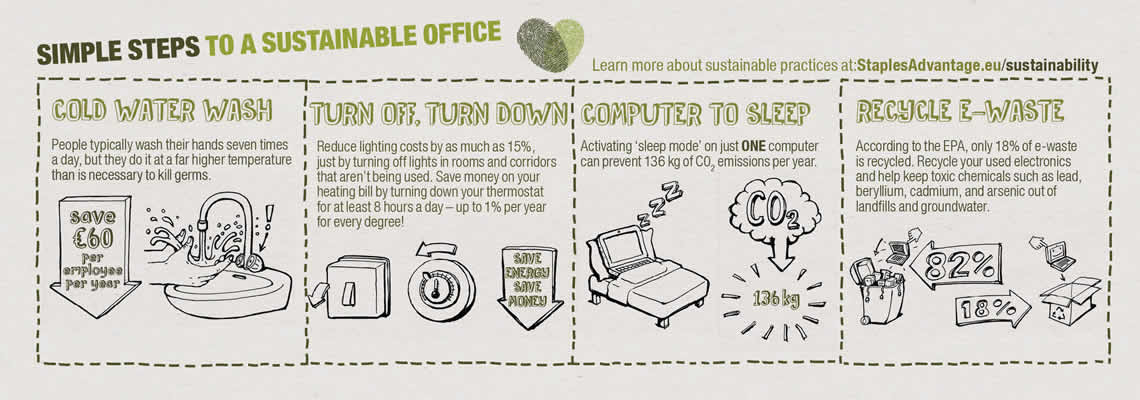
Changing a few everyday office habits and adjusting how you purchase and use products can have a huge impact on your company’s CO2 footprint. If you’re still clinging to throwaway habits, think about what you could change. Here are some suggestions to help you on your way, from quick-fixes to long-term solutions:
1. Look for energy-saving certifications when purchasing new equipment, such as the ‘Energy Star’ certification, and if your current equipment has energy saving settings, make sure they’re active.
2. Choose multi-functional devices, such as all-in-one printers that can print, copy and scan documents. Such devices use much less energy than individual machines and have been proven to reduce overuse, because employees who have to walk to a shared machine are less likely to do so unnecessarily.
3. Stimulate your staff to save electricity and give their health a boost by skipping the lift or escalator and taking the stairs. Also ask them to put their computers to sleep when they’re away from their desks. Activating “sleep mode” on just one computer can prevent 136 kg of CO2 emissions per year. However, because computers left on standby still consume 50% as much power as when in use, all computers should be shut down properly when leaving for the day.
4. Use energy-saving technology to automatically switch off computers, monitors and printers after hours. Doing so will not only help reduce your C02 but prevent most of your electricity bill paying for power consumed by machines on standby, saving you money.
5. Install only cold water taps in washrooms to save Euro 60 per employee per year. People typically wash their hands seven times a day, but they do it at far higher temperatures than is necessary to kill germs.
6. Turn off the lights in rooms and corridors that aren’t being used to reduce lighting costs by as much as 15%. Roughly 40% of the electricity used in a typical office building is used for artificial lighting. And while most offices have switched to energy-saving light sources, lights are often left burning around-the-clock. Use natural daylight as much as possible and install motion-activated light switches.
7. Install a programmable climate control model at a comfortable level throughout the year, which automatically turns off the heat and air-conditioning after hours. By turning down your thermostat for at least 8 hours a day, you can save up to 1% per year for every degree!

8. Rethink your printing habits. Implement a print policy that encourages saving files digitally instead of printing everything out. In terms of paper use, it is estimated that approximately 18 trees are cut down for every 10 employees per year. To save paper, set photocopiers and printers to default to single copies and print double-sided. It also makes sense to buy sustainable office paper and eco-conscious ink cartridges.
9. Minimise the number of small, inefficient orders you place. This cuts back on excess packaging and transport emissions and has the added benefit of reducing your administration costs.
10. Consolidate your product categories. Using one primary supplier across all categories will result in even greater efficiency in the use of packaging materials, transport costs, and administrative resources.
11. Choose natural consumables and furnishings for your office. Many products used in the office environment contain unpleasant substances. From chemical cleaning products and toxic printing consumables that need to be handled with care and disposed of correctly, to furnishings and décor, which leak less welcome compounds into the atmosphere, such as formaldehyde.
12. Recycle. It’s estimated that for every tonne of paper recycled, about 17 trees and some 26,500 litres of water is saved. Recycling helps to reduce eight types of water pollutants and 10 varieties of air pollutants and eases the strain on landfills. This is particularly important for office electronics and batteries, which contain chemicals that could contaminate groundwater, yet according to the EPA, only 18% of e-waste is recycled.
13. Use refills to dramatically reduce your office’s carbon footprint. Over four million disposable pens are thrown out daily in the USA alone, so why not stock the supply cupboard with reusable pens and refills instead?
14. Buy eco-conscious products. Investigate whether the products you buy are made with recycled, renewable or recyclable materials, or simply choose from Staples’ range of over 12,000 planet-friendly products.
15. Implement a one-stop sustainability solution. Going green can be a daunting task. Staples’ new Easy on the Planet programme was designed to help you reach your company’s sustainability objectives using a customised plan that tracks your progress and helps finds ways to improve it.
You can call a Staples representative at the following number:
+44 (0) 121 322 1000
You can also fill out the form below and one of our representatives will get in touch with you shortly.